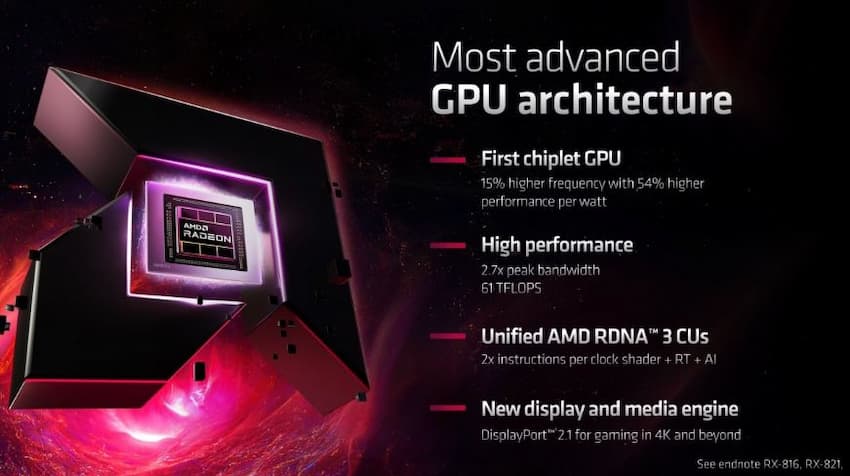AMD has launched the world’s first chipset-based graphics cards for gamers. The innovation is AMD’s next gen generation desktop graphics cards.
The company revealed the two new flagship products, the Radeon RX 7900 XTX and the RX 7900 XT.
They are based on the new RDNA 3 architecture.
AMD claims that its 7900 XTX can be up to 1.7x faster in pure rasterization and up to 1.6x faster in ray tracing at 4K compared to the 6950 XT.
The company’s Radeon RX 7000 line are its competing series against Nvidia’s recent GeForce RTX 4000/Ada Lovelace architecture.
Shipping and Cost:
AMD said shipping would begin on Dec. 13 at $999 and $899 for the RX 7900 XTX And RX 7900 XT, respectively.
Both cards are intended for 4K, high frame rate, high quality gaming and streaming, but AMD’s also pitching the XTX as an 8K gaming GPU.
ALSO READ: How Intel, Qualcomm Chip Manufacturing Deal Affects Your Phones
And to prove 8K is coming, the company teased an upcoming Samsung Odyssey Neo G9 8K widescreen monitor slated for its official announcement at CES in January.
The company also says that we’ll be seeing high-res DisplayPort 2.1 monitors starting in the beginning of 2023 from companies like Dell, Asus, LG and Acer and Samsung.
Specifications:
The GPU die has two main components, viz: the Graphics Compute Die or the GCD and the Memory Cache Die or the MCD.
AMD built the GCD using the new 5nm manufacturing process. For the MCD, AMD used the older 6nm process.
The GCD features the new RDNA 3 compute units, new display engine, and a new dual media engine.
Also, each compute unit has 1.5x VGPR (Vector General Purpose Register), 64 dual issue stream processors with 2x instruction issue rate, 2x AI accelerators with 2.7x performance, and 2nd Gen RT accelerator with 50% more performance per CU.
The new MCD has 64-bit memory controller and 2nd Gen Infinity Cache for 2.7x peak memory bandwidth.
The cards:
The RX 7900 XTX has 96 compute units, 2.3GHz game clock, 24GB GDDR6 384-bit memory with 96MB Infinity Cache.

AMD Radeon RX 7900 XTX
It also has a 355W board power limit that can be powered by two 8-pin connectors.
For the 7900 XT: It has 84 compute units, 2.0GHz game clock, 20GB GDDR6 320-bit memory with 80MB Infinity Cache, and a 300W board power limit.

AMD Radeon RX 7900 XT
Meanwhile, both cards support the new DisplayPort 2.1 standard limited to the intermediary UHBR 13.5 bandwidth of 54Gbps.
They also support a new media engine with simultaneous encode/decode for AVC/HEVC and 8K60 AV1 encode/decode.
The 7900 XTX is priced at $999 and the 7900 XT is priced at $899. They will be available December 13.

AMD Radeon
In addition to AMD’s in-house cards, third-party cards will be available from AMD’s usual partners, such as Asus.
What you should know:
This is the first graphics card with such chipset-based design.
AMD switched to a chiplet-based design to allow the company mix and match parts for different configurations.
This mixture also lets the company use different manufacturing processes for each component.
The smaller parts also have better yields than making a single large monolithic die, which helps the company manufacture these parts cheaply and efficiently.



















 and then
and then